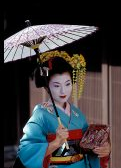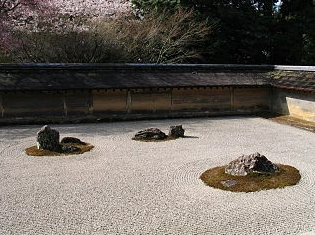After exciting and stylish Tokyo, we were whisked to Kyoto City on high-speed rail.
 |
Aerodynamic Nose of the Fabled
Shinkansen, or "Bullet Train" |
 |
| Second Class, Green Car |
 |
| Village with Rice Paddies |
Kyoto, the ancient capital of Japan, has a population of 1.4 million people and is surrounded by verdant forested hillsides, countless treasured Shinto shrines, and Buddhist temples. Kyoto was spared the destructive air raids and bombings of WWII allowing visitors to get a glimpse of Japanese culture dating as far back as the sixth century A.D. Kyoto neighborhoods are characterized by intimately narrow streets. Which are lined with tiny retail shops and single-family residences. Lush tree canopies shade the city's many neighborhoods, bridges, and walkways.
 |
| Beautiful View from Wooden Bridge |
 |
| Peaceful, Narrow-Streeted Neighborhood |
The city is impeccably clean yet not sterile; it is personal and yet mysterious; every door and plant seemed fresh and timeless. We absolutely loved it!
 |
Moss Garden.
The carpet of moss is swept daily; weeding, on
the occasion includes the deployment of tweezers. |
Hiiragiya Ryokan was our "home" for 48 memorable hours. Hiiragiya is a traditional Japanese inn with a long and beloved reputation. Owned and managed by the same Kyoto family since 1818, the staff takes personal pride in creating an atmosphere where visitors can feel as though they have come home.
 |
| Reiko and our Attendant Hitomi |
 |
| "As if returning home." |
While the inn is understated elegance and simplicity, it has been the guest house of choice for many visiting politicians, artists, celebrities, and even curious RTW travelers.
 |
| Dressed for Dinner |
All of the 28 guest rooms are unique; all rooms have "grassy" scented tatami mats, sitting areas open to private gardens, and private baths with tubs made of aromatic fir. The inn and guest rooms are characterized by all-natural woods, sliding fusuma doors, hand-painted screens, and traditional silk tapestries.
 |
| Living/Dining/Bed Room |
 |
| Sitting Room Overlooking Private Garden |
 |
Alcove with Hanging Scroll, Lacquered Table
and Flower Arrangement |
Upon arrival, our personal attendant introduced us to the customs of the ryokan and the etiquette for dressing, bathing, eating, and sleeping. Our street shoes were left at the front entry and returned to us upon leaving each day. Shoeless feet were a requirement when walking on the tatami mats. We were provided with slippers for other areas of the inn, and the slippers were always supposed to be left at the threshold upon entering our guest room. We never quite got the shoe ritual completely correct!!
 |
| Joan's and Gus' Slippers |
Our attendant served our meals.
 |
Kaiseki Meal.
Thirteen courses included tofu, seafood, local vegetables,
and rice. Each flavor is visited - salty, sweet, bitter, sour,
and umami. |
She filled our soaking tub, prepared the futon before bed, and made certain we were surrounded by a serene, contemplative experience. It was actually a lot of fun to "try on" a very different way of being.
 |
What Was Gus Thinking?
|
When we weren't eating, bathing, soaking, or sleeping, we headed out to discover Kyoto.
 |
| Ilsu - san, our Exceptional Guide |
At the Ryoan-ji Temple, we sat before a Zen garden composed of 15 rocks, arranged in five separate groupings. No one picture could capture them all.
There are various interpretations of the rocks' symbolism, but it is said that, like Zen itself, the riddle can be unraveled only by silent contemplation. We arrived along with many groups of children in matching school uniforms. While contemplating the neatly raked pebble garden with its 15 rocks, everyone sat, . . and moved and sat again, . . .trying to count all 15 rocks at once. But no one can, or could! The intent was to show that no one is perfect; no one sees the entire picture. Our experience in the zen garden is one of the memories we will not forget!
 |
| Contemplate this, Monet-san |
 |
Middle School Students,
from Tokyo, on their End-of-School Field Trip
|
Next, we visited Rokuon-ji Temple or commonly called the Golden Pavilion, and Kyoko-chi ( beautiful Mirror Pond).
 |
Kinkaku,
the elegant main building of the Rokuon-ji Temple
 |
Created from scraps of paper and pieces cut from postcards - Vik Muniz
 Kyoto is the only city in Japan where Geisha are trained and still perform in dinner clubs and inns. The Geisha profession dates back to the 17th century, and their training in traditional arts and dance is both expensive and requires a full-time commitment. We drove through Gion-hobu, a neighborhood of members-only dinner clubs, and spotted several geisha, in full costume, walking to their performance for the evening. We missed the women due to camera problems; a wonderful website to check out is Geishas of Kyoto.When a geisha trained woman decides to marry or pursue a different career, she gives up her rights to be geisha. Today, geisha prefer the term Geiko ( women younger than age 20) and Maiko ( women over age 20), due to the stigma surrounding the so-called onsen geisha who were considered as glorified waitresses and escorts with sexual favors.
Kyoto is the only city in Japan where Geisha are trained and still perform in dinner clubs and inns. The Geisha profession dates back to the 17th century, and their training in traditional arts and dance is both expensive and requires a full-time commitment. We drove through Gion-hobu, a neighborhood of members-only dinner clubs, and spotted several geisha, in full costume, walking to their performance for the evening. We missed the women due to camera problems; a wonderful website to check out is Geishas of Kyoto.When a geisha trained woman decides to marry or pursue a different career, she gives up her rights to be geisha. Today, geisha prefer the term Geiko ( women younger than age 20) and Maiko ( women over age 20), due to the stigma surrounding the so-called onsen geisha who were considered as glorified waitresses and escorts with sexual favors.
After recharging our battery, the next point of interest that we visited was Ryozen - Kannon. A massive 80 foot Kannon dominates this memorial. Beneath the concrete statue resides a practicing Buddhist temple. Inside the shrine are the memorial tablets of two million Japanese who died in WWII. Memorial services are conducted four times each day at the shrine.
 |
Concrete statue of the Bodhisattva Avalokiteśvara.
Leaving the WWII memorial, we next visited the Sanjusangen-do temple. The temple contains one thousand life-size statues of the Thousand Armed Kannon. The statues are made of Japanese cypress. Around the 1000 Kannon statues stand 28 statues of guardian deities. Pictures were not allowed inside, but here are a few outside clicks...
 |
Long Hall of Sanjusangen-do Temple
On the Sunday before the Coming-of-Age-Day the
the temple hosts an archery contest for young women,
who shoot arrows from one end of the veranda of the
main hall to the other. |
 |
A tsukubai is a basin provided in Buddhist
temples for visitors to purify themselves by the
ritual washing of hands and rinsing of the mouth. |
 |
| Landscaped Gardens |
Time to return to Tokyo for an overnight stay and then on to Thailand for a week and a half.
|
 Kyoto is the only city in Japan where Geisha are trained and still perform in dinner clubs and inns. The Geisha profession dates back to the 17th century, and their training in traditional arts and dance is both expensive and requires a full-time commitment. We drove through Gion-hobu, a neighborhood of members-only dinner clubs, and spotted several geisha, in full costume, walking to their performance for the evening. We missed the women due to camera problems; a wonderful website to check out is Geishas of Kyoto.When a geisha trained woman decides to marry or pursue a different career, she gives up her rights to be geisha. Today, geisha prefer the term Geiko ( women younger than age 20) and Maiko ( women over age 20), due to the stigma surrounding the so-called onsen geisha who were considered as glorified waitresses and escorts with sexual favors.
Kyoto is the only city in Japan where Geisha are trained and still perform in dinner clubs and inns. The Geisha profession dates back to the 17th century, and their training in traditional arts and dance is both expensive and requires a full-time commitment. We drove through Gion-hobu, a neighborhood of members-only dinner clubs, and spotted several geisha, in full costume, walking to their performance for the evening. We missed the women due to camera problems; a wonderful website to check out is Geishas of Kyoto.When a geisha trained woman decides to marry or pursue a different career, she gives up her rights to be geisha. Today, geisha prefer the term Geiko ( women younger than age 20) and Maiko ( women over age 20), due to the stigma surrounding the so-called onsen geisha who were considered as glorified waitresses and escorts with sexual favors.


























No comments:
Post a Comment